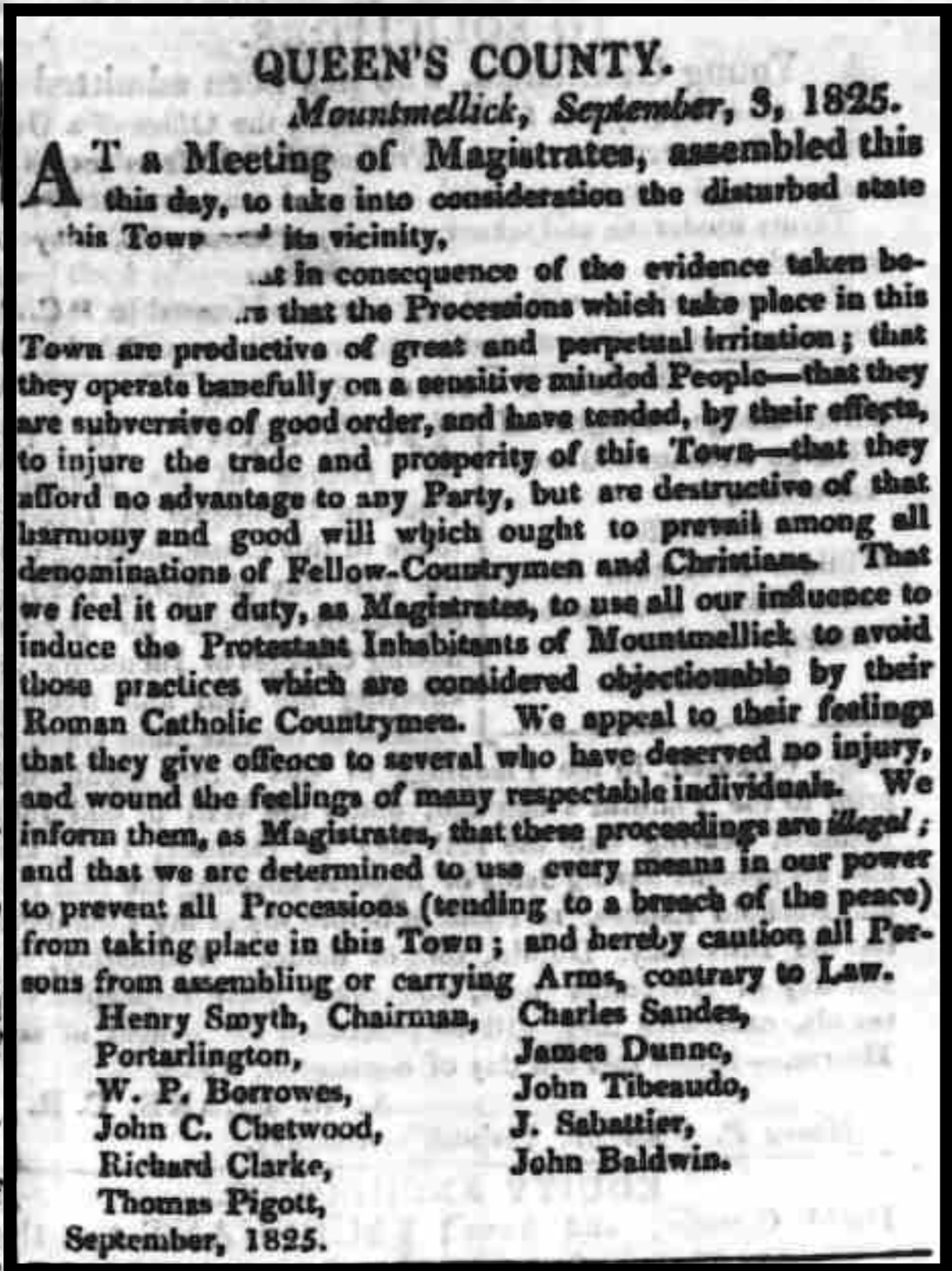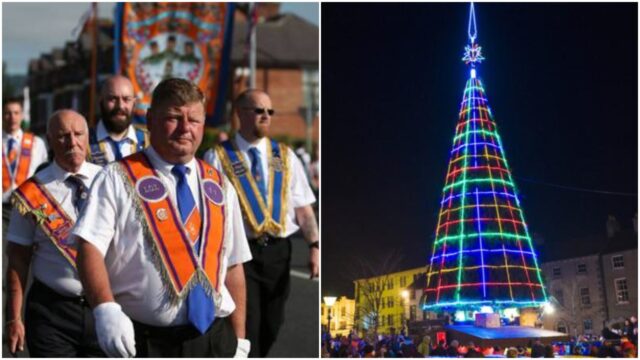As the 12th of July approaches each year, those of us living in the Republic of Ireland primarily view the events associated with it remotely through the media.
By and large the Orangemen, Orange Parades, the Marching Season and ensuing social tensions have generally speaking been confined in living memory to Northern Ireland. The 12th of July is something we are certainly aware of in 26 counties but its practicalities are, for the most part, experienced by those living in the other 6.
However, two hundred years ago as Mountmellick entered the 1820s the issue of the 12th of July was a reality for the town and one which confronted the townspeople on their very own doorstep. Less than 25 years before there had been the Rebellion of 1798 which divided the country.
There stands today on Wolfe Tone Street in Mountmellick a monument to the eleven local United Irishmen who were executed by the authorities for taking part in the uprising. This Nationalist monument was erected a century after the Rebellion had taken place.
Conversely, there was a Loyalist symbol in Mountmellick which took on an enhanced significance and functioned as an immediate de facto monument following the uprising.
With the wounds inflicted during the 1798 Rebellion not yet healed, its memories still vivid and emotions still raw among the town’s inhabitants, this particular memorial would become the focal point of immense bitterness and acrimony in Mountmellick for almost thirty years, particularly on the 12th of July when the town was gripped in a highly incendiary and toxic atmosphere.
The Orange Pole in Mountmellick became the Loyalist testament to the suppression of the Nationalist Insurgents in 1798. It was located upon the Market House which was once situated in the centre of the Market Square (O’Connell Square).
It was actually inside the Market House where the army stationed two nine-pounder cannon during the 1798 Rebellion in their attempts to retain law and order. When the Rebellion was quashed, the Orange Pole was erected “with a flag floating from it in the breeze of heaven, at an altitude of some 52 feet.”
Incidentally, a pen and ink sketch of the Market Square from September 1850 shows no trace of the Market House at this time. It is unclear when exactly it was demolished.
The Orange Lodge in Mountmellick took immense pride in their symbol of victory and apart from the Orange and Williamite flags which were raised on the pole such as the Union Jack and the Boyne Standard, they would lavishly decorate it for the 12th of July with ribbons, flowers and garlands.
On top of the Orange Pole was a double-sided tin plate which had the equestrian figures of King William of Orange on one side and King George on the other.
The Orange Pole was the centrepiece of the formalities surrounding the marches – or processions – which took place on the day and these were complete with fifes, drums, banners, sashes, gunshot salutes and songs including Croppies Lie Down.
Mountmellick had by the start of the 1820s acquired a reputation nationally, along with other towns such as Bandon, as being a hotbed of Orangeism due to the annual reports carried in the country’s newspapers detailing the riotous, alcohol-fuelled behaviour between Catholics and Protestants which occurred in the town on the 12th of July, which was in no small part due to the large influx of persons into Mountmellick on the day who hailed from areas outside of the town’s immediate environs.
These reports were damaging to Mountmellick’s national standing which, crucially, was based primarily at the time on the town’s industrial might.
So much so that in July 1821 Mr. Richard Warburton from Garryhinch wrote a letter to one newspaper in his capacity as a Magistrate seeking to downplay their report of the events in Mountmellick on that year’s 12th of July.

Protestants from Mountmellick also wrote to newspapers at the time in an attempt to assign blame for these controversial events on a small, unruly and wholly insignificant rabble of Orangemen whose actions were unrepresentative of the Protestant community in the town as a whole.
Some also wrote seeking to provide a balance to the reports by claiming a continuous harassment of the Protestant community by the Catholics of Mountmellick.
Regardless of the exact nature and scale of these occurrences, there was no denying that the 12th of July was a perpetual source of rancour and division in Mountmellick.
Unfortunately for Mr. Warburton and the other Magistrates in the locality, this particular type of bad press for the town was not just confined to the month of July.
Reports were carried nationwide during February 1823 about the effigy of a lawyer named William Conyngham Plunkett being dragged by a donkey and a person dressed up as a hangman through the streets of Mountmellick from the Orange Lodge to the Orange Pole, all the while accompanied by an unruly chorus of cheers and jeers from a drunken group of Orangemen. This procession was led by a man dressed up as a sheriff. A gallows was erected at the Orange Pole and the effigy was first hung before being set on fire following a mock trial.
1825 was the year when the disorder in the town of Mountmellick on the 12th of July reached a point where it could no longer be tolerated by the Catholic populace nor ignored by the government, despite their public utterances and proclamations condemning the disorder.
In the lead up to the day itself, the by now yearly forecasts detailing scenes of riot, tumult, discord and insult that the town had become accustomed to seeing were being made. Not only did the events of day itself fail to betray these predictions, they in fact exceeded them.
Such alleged instances included the firing of powder into the face of a Catholic Priest and a procession to the Catholic Church with the firing of blank cartridges at it in triumph. Shots were also reported to have been fired into the houses of prominent Catholics. This was on top of accounts describing the typical panorama of licentious behaviour and the routine intimidation of Catholics.
The Catholic townspeople sought the intervention of the local Magistrate, Mr. Robert Kenny, on this day but no meaningful assistance was forthcoming. This was allied to frequent complaints of policemen not only failing to intervene on the behalf of Catholics, but actually siding with and aiding the Orangemen in confrontations.
This led to a communication being sent to the Lord Lieutenant pleading for his intercession. Featured prominently in this communication was a reference to the Orange Pole and its principal purpose as a beacon of antagonism by the Orangemen of the town.

The Lord Lieutenant ordered a meeting of the Magistrates in Mountmellick, which took place in September 1825. The local Parish Priest, Rev. Anthony Duane, played a vital role in presenting the case for the Catholic community in the town and in providing evidence of the disdainful treatment of Catholics by the Orangemen on the 12th of July. Consequently, a resolution was passed outlawing Orange processions in Mountmellick.
The passing of this resolution alone was not enough for the Catholics of Mountmellick. They demanded that the Orange Pole be permanently removed from the Market House. For as long as it remained there, it served in their eyes as a visible reminder that the government of the country explicitly condoned the behaviour of the Orangemen towards Catholics in the town.
Alluded to in this resolution was a campaign which the Catholic community had commenced of deliberately setting out to damage the town’s trade through the adoption of a non-consumption policy of certain locally produced goods in an attempt to force the hand of the influential businessmen and respected figures in Mountmellick whom the Catholics believed not only could, but should, do more to curb the behaviour of the Orangemen, particularly as many were in their employment.
In other words, “they would grope their way to a sense of justice in John Bull’s heart through the medium of his breeches pocket.” This type of campaign was a forerunner to what would later become known as Boycotting.
The businesses of two men in particular were singled out for special attention as part of this campaign. They were Mr. Robert Kenny and Mr. Anthony Pim.
Both men owned breweries in Mountmellick and the Catholics in the area pledged not to drink a drop of the beer – “Orange Beer” as it became known – produced by their respective breweries for as long as the Orange Pole stood.
This impacted significantly upon their trade, not least because breweries at this time relied upon the local consumption of their beer as there was neither the infrastructure to transport it long distances nor the advancement in brewing techniques that could preserve the product for extended periods of time. Why were these two men singled out?
In Anthony Pim’s case it was because the Orange Pole was located on top of his premises, the Market House, which according to a map of Mountmellick circa 1820 was situated across from his home on Market Street (Parnell Street).
In Robert Kenny’s case it was because he, as mentioned already, was a Magistrate with a sworn duty to maintain law and order in the town. He also had the power to seek the lawful removal of the Orange Pole if necessary in order to keep the peace in Mountmellick. His perceived unwillingness to adequately deal with the behaviour of the Orangemen and with the issue of the Orange Pole itself drew the ire of Catholics.
It was becoming increasingly clear to those in positions of power – locally and nationally – that the disruption which this Williamite ensign was causing to the town of Mountmellick was proving to be far more trouble than it was really worth. Aside from the havoc and carnage which manifested around it on the 12th of July, the campaign initiated by local Catholics to hurt the trade of Mountmellick businesses deemed sympathetic to the Orangemen was having the desired effect.
Early 1826 offered little hope that there would be any significant cessation in hostilities in the lead up to the 12th of July that year. In February it was reported that the Orange Pole had been defaced with paint by enraged Catholics, an act which only served to fan the flames of animosity.
In the months that followed, the local Magistrates submitted a request to the government for assistance and support in removing the Orange Pole, but with the 12th of July looming any directives issued to have it removed were either delayed or just simply ignored, as was the case with an order passed to a Major named Powell who disregarded a command to remove the offending emblem.

However, one day in early June 1826 a combination of police and soldiers numbered to the region of 150 cavalry and infantry were led by six Magistrates into Mountmellick and assembled at the Market House, where they were confronted by a group of Orangemen. An account from the day itself describes the scene:
The crowd now gathering in the streets, as group after group poured on through the various roads and avenues leading into the place, gradually swelled into thousands. Every town, village and country side for miles around contributed its quota – Maryborough, Shinrone, Portarlington, Monasterevan, Kildare, Mountrath, Castletown, Abbeyleix, etc etc.
There were brine oges from Ballyfin, colleens from Dunamaise, gossoons from Rosenallis, jackeens from Ballyragget, rockites from the Slieve Bloom Mountains, white boys and blackfeet, Orangemen and Ribbonmen. A long line of red-coated soldiers in heavy marching order, a few troops of light cavalry from a distant garrison, and small detachments of peelers from various guard houses, wherever they could be spared.
The Magistrates issued the order for the removal of the Orange Pole, although a number of officers laid down their arms in protest at the order. A fracas followed, but a few of the troops had already made their way into the Market House and towards the Orange Pole where it was struck with an axe.
The Orange Pole, the Orange flags and the double-sided tin plate depicting the images of King William and King George, all of which had looked out over the town of Mountmellick for nearly thirty years, came crashing to the ground accompanied by howls of rage from the Orangemen and exultant cheers from the Catholics.
The incandescent Orangemen attacked the government forces with missiles and vicious fighting erupted, but due to their numerical disadvantage the Orangemen were overcome and the crowds were dispersed from the Market House.
The procession by the Orangemen in Mountmellick on the 12th of July that year had been cancelled by the local Magistrate, Mr. Robert Kenny, in the interests of public order and safety.
Aware of the particular sensitivity in the town in light of the Orange Pole’s removal the previous month, Dublin Castle sent protection to Mountmellick in the form of a party from the 7th Dragoons who arrived from Newbridge.
Unsurprisingly, the 12th of July 1826 did not pass peacefully due to the heightened tensions and there was a repeat of the skirmishes that had blighted the town in previous years.
This time, however, there would be repercussions for the instigators of the violence as in October of that year the Maryborough (Portlaoise) Sessions was the scene for the trial of Orangemen charged with causing a riot in Mountmellick on this day along with other indictments of assault.
Mr. Phelan, legal representative for the Orangemen, proposed that if the charges were dropped against his clients then they gave their word that they would in the future and forever abstain from displaying their colours in the town and would dispose themselves to live in peace with their Catholic neighbours.
The Magistrates, along with Rev. Anthony Duane, spoke of their willingness to accept the Orangemen’s proposal if it genuinely meant an end to the 12th of July hostilities which had devastated Mountmellick for far too long.
All parties prioritised the need to make a fresh start for the good of the town. The proceedings concluded with a rapturous round of applause in which all parties present in Maryborough that day joined in: Catholics, Protestants, Magistrates and Grand Jury.
The removal of the Orange Pole initiated a sea-change in the attitude towards the Orange processions of the 12th of July in Mountmellick which saw a tangible easing of the religious strain in the town over the years that followed.
On the 12th of July 1827, Mountmellick, with a strong police presence in the town, witnessed neither the processions nor any of the fanfare that had come to be associated with the Orangemen. The day passed without a disturbance of any significance being reported.
Seventeen years after the felling of the Orange Pole, Daniel O’Connell led a Repeal procession in August 1843 from Mountmellick to Maryborough in which numerous members from the town’s Protestant community marched shoulder to shoulder alongside their Catholic neighbours with any demonstrations of objection by the local Orangemen on the day being relegated to that of a mere sideshow.
Twenty years later, in the early 1860s, a new convent was built by the Presentation Sisters on Bridge Street (Sarsfield Street) upon which a statue of the Immaculate Conception was placed at its highest point and this was believed to have been a cause of great offence to a section of the local non-Catholic population.
For those alive at the time who were old enough to remember the town’s Orange Pole, the thought must surely have crossed their minds that this was a case of the shoe now firmly being on the other foot.
Messrs. Kenny and Pim failed to escape the indignation of the Orangemen of Mountmellick once they sensed a wavering in both men’s stance on the issue of the Orange Pole’s removal. The following is a verse from a song which they composed in order to succinctly express their opinion of the two brewers:
It’s of Mountmellick town you quickly shall hear,
A comical ditty about Kenny’s beer,
Not a drop can be sold throughout country or town,
‘Till Will in the market place he is pulled down,
Sing Bubbero diddero Anthony Pim,
Put your specs on your nose and at Will you may grin,
All your barking and biting you may as well stop,
For we’ll keep him up there if you ne’er sold a drop.
The story of the Orange Pole itself did not end on that June day in 1826 after it had been felled from above the Market House to lie broken and splintered along with its torn and tattered flags in the dust and dirt of the ground below.
The Orangemen rescued their battered, but still revered, totem from the ground outside the Market House and erected what was left of it straight away upon a water pump at another location in the town of Mountmellick.
The Orangemen rallied around the pole at its new location and defended it heartily once again with all their might against the government forces but inevitably were overcome due to their numerical disadvantage, and the Orange Pole was forcibly removed from its temporary abode.
This time the Orange Pole was gathered up by Mr. John Fitzgerald, whose house was reported to been situated opposite the water pump, and he erected what remained of it and its adornments in his back garden. Mr. Fitzgerald then proceeded to place a placard outside his home warning potential trespassers:
Take notice that anyone who enters these premises shall be shot ACCORDING TO LAW!
Reminiscing some 70 years after this event, C.L. Hutchings indicated the location of John Fitzgerald’s house as being on Forge Street (Emmet Street).
The Orange Pole became part of the town’s folklore even if, as the following passage demonstrates, that in all examples of folklore the facts generally tend to get interweaved with a healthy dose of historical inaccuracy and conjecture.
It would be quite something, though, if the Orange Pole was still operating as a beam in someone’s shed!
The Orange Pole
About the year 1800, there was a pole at McEvoy’s Corner, Mountmellick, Laoighis, called the “Orange Pole.” Mr. Lyons and Mr. Chambers, both from Mountmellick, were in charge of it. The Catholic people of the town were obliged to raise their hats while passing the pole. One night an R.I.C. man cut down the pole, and after a short time he was dismissed. It was not put up again, and it now serves as a beam in a shed, owned by Mr. Chambers, a descendant of one of the men who owned it. There are descendents of Mr. Lyons in Mountmellick also.
Many years after the Orange Pole had been removed from the Market House, a recount of the deep religious tensions which had existed in the town during the early nineteenth century mistakenly referred to it as an Orange ‘Tree’ that had been once situated in the town’s Market Square and which would be abundantly decorated by the Orangemen for the 12th of July.
However, this error would turn out to be quite prophetic because in the exact same spot where the Orange Pole once stood now stands, and at virtually the same height, the magnificent and well-renowned Christmas Tree of Mountmellick.
Whereas once upon a time Mountmellick was, for a period, famed for the Orange Pole which became a recognised symbol of prejudice and bigotry, now each year our celebrated Christmas Tree invites everyone who visits the town to spread its message of ‘Peace To All.’
SEE ALSO – Portlaoise councillors push for extended pedestrianisation of Main Street


























